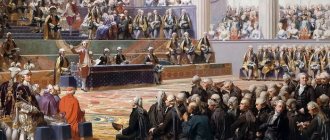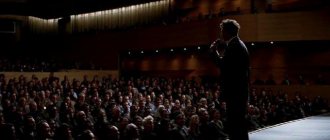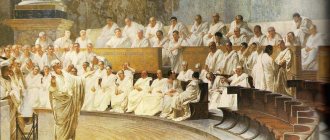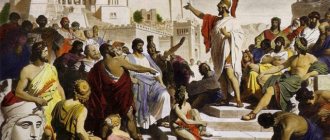Rhetoric in the Middle Ages
The main feature of the medieval era is its deep relationship with religion.
The main type of oratory for this period became spiritual eloquence.
Church ministers retell sacred dogmas and biblical legends.
The main method of influencing the listener is suggestion, not persuasion.
Homiletics is actively developing: the auxiliary science of theology explains church theory and introduces preaching literature.
Noteworthy are the works of the Spanish Archbishop Isidore of Seville and the Anglo-Saxon chronicler and monk the Venerable.
In their works, rhetorical terminology is clearly explained, and the material is systematized. The Church during this period is considered the largest feudal landowner. Everything was subordinated to theology: social institutions, philosophy, art, education.
With the advent of higher educational institutions, university eloquence appears. It is also closely connected with the church and is based on scholasticism. This philosophy relies entirely on religious authorities and neglects everyday experience.
John Chrysostom is considered one of the greatest writers of that time: he perfectly combines an ancient rhetorician and a Christian theologian.
He was considered the protector and patron of the weak and poor, as well as those whose work is related to oratory - teachers and lawyers.
Introduction
Oratory is the art of constructing and delivering a speech in public with the goal of influencing an audience. A similar interpretation of oratory was accepted in ancient times. Oratory is also called the historically established science of eloquence and an academic discipline that sets out the fundamentals of oratory.
In ancient times, rhetoric was considered as the science of argumentation in public speech, necessary when discussing practical issues. Later, rhetoric was borrowed by the Romans, adapted to the needs of Roman society and improved not only as a stable system of scientific concepts, but also as an educational subject.
In the XVII–XIX centuries. Rhetoric began to be understood as the science of argumentation primarily in written speech: the social importance of oratory at this time decreased, and the importance of written literature - theology, religious and political journalism, philosophy, historical prose, documents - increased. Private rhetoric is gradually developing, in which the rules for creating specific types of works are formulated - court speeches, sermons, letters, business papers, historical, philosophical, scientific essays, etc.
In the second half of the 19th century, rhetoric was excluded from the education system, and its place was taken by the compulsory study of artistic works and the opinions of literary critics on various issues of public life.
Modern neo-rhetoric brings a return to the heritage of Christian culture, taking into account modern scientific knowledge.
All European rhetoric is based on ancient rhetoric. The works of Aristotle, Cicero and other authors of the ancient world had a huge influence on those who created rhetoric in other countries, including Russia.
Rhetoric in the Renaissance
During the Renaissance, rhetoric received a new round of development. Business and parliamentary eloquence appears; judicial - is reborn. During the Renaissance, the emphasis is on human individuality.
The orator-philosopher Cicero becomes a role model. And although he was not an original thinker or the creator of his own philosophical system, the writer sought to introduce people to the latest events and provide material for meaningful reading and self-education. Rhetoric is closely intertwined with literature.
The personality of man and his freedom began to manifest themselves more clearly than ever in speech. People tried to discern rhetorical possibilities in their native language, relying on the impressive experience of ancient authors.
The fiction of that time strives to improve speech culture, enhances verbal sensitivity, tries to show the expressive capabilities of language and instills an aesthetic taste for the word.
A classic example of Renaissance oratory is the monologues of Hamlet, Juliet and other Shakespearean heroes.
Rebellious sermons are becoming popular in the church environment. The Italian monk Savonarola actively criticizes the Vatican and the luxury of the Catholic Church. And Jan Hus, holding the position of rector of the University of Prague, delivers his sermons in simple folk language and knows how to skillfully change the form of presentation of thoughts depending on the target audience.
The priest was considered a national hero of the Czech Republic. In his words people found justice and honesty. Hus carried out a reform of Czech spelling, after which books became available to the common classes.
Rhetoric is an integral part of the culture of any people. Thanks to this discipline, ideas and ideas for a particular historical society are affirmed.
At the same time, another important function is realized: rhetoric is a mediator between people and establishes mutual understanding between them.
Related posts:
- What is "War and Peace" about? Summary of the novel “War and Peace” by chapters. All answers...
- Rhetoric - traditional and modern Modern rhetoric - the origins of oratory. Rhetors of the times of Ramus and...
- Ancient Greek rhetoric The reasons for the emergence of the art of rhetoric in Ancient Greece. Its founders. Influence…
- Logorhythmic classes and correctional means By various means, speech therapy classes contribute to the effective correction of speech in children...
Rhetorical culture of the Renaissance
The culture of the Renaissance owes its name to the main idea of this period - the idea of the revival of ancient learning as the basis for the education and development of man with his universal, limitless possibilities.
Chronologically, this is the time of the 14th – 16th centuries. All European countries, to one degree or another, experienced the influence of deep revival processes that manifested themselves in Italy back in the 13th century. As always, these boundaries are quite arbitrary; the origins and consequences of such a vibrant and turbulent cultural phenomenon are found beyond its borders.
The revival of Antiquity meant, first of all, the rise of humanitarian and, above all, secular knowledge. Changes in ideological and spiritual guidelines also determined changes in rhetoric. On the “upper floors” of culture, in the works of philosophers, scientists, and poets, an ideal idea of a person, his essence and purpose is formed and offered to society, and an ideal of speech and speech behavior is developed.
The ruler of Florence, Cosimo de' Medici, founded the Platonic Academy at court, which united remarkable people of his time, such as Marsilio Ficino, Pico della Mirandola, Cristoforo Landino, Lorenzo the Magnificent and others. Marsilio Ficino is the soul and ideologist of the academy, philosopher, poet, doctor, speaker, mystic, one of the most outstanding people of his time.
According to Marsilio Ficino (1433-1499), “man is the greatest miracle in nature, for everything has a separate and private character. Only a person is everything at once. It contains the divine ideas on which it depends, as well as rational foundations and examples for lower creations... He is the bond of the world, he constitutes the true connection of the universe, he combines spirit and flesh, heaven and earth”[20]. Pico della Mirandola (1463-1494) expresses, at first glance, the opposite, but in fact the same opinion, saying that man is neither an earthly nor a heavenly being. He is what he wants to become, that is, he is pure possibility. At birth, the seeds of all things are laid in him by the heavenly father. What happens next depends only on his choice and will. A free and glorious master, he crumples and forges himself into the shape he pleases. In addition to the physical body, he has a spirit, and his position is determined not by this weak body, but by the spirit. Reason, intellect moves a person.
If the Middle Ages insists on the sinfulness, weakness and imperfection of people (for example, Cardinal Lothair called his work “On the Wretchedness of the Human Condition”), then the Renaissance glorifies the divine essence of man, his free will, which manifests itself in thoughts, words, and in business.
No matter how abstract all these ideas are, they found their expression in reality. The era is full of names of strong personalities, talented and multifaceted people. Not a medieval ascetic, but a cheerful and active person with all his passions gains public recognition. He is expected to demonstrate various abilities, creative and artistic skills are especially valued. So, for example, a perfect courtier should ideally have a set of various qualities, mental and physical, in harmony with each other. Among them are the ability to sing and dance, understand music, and understand works of art and painting. The courtier is required to have the broadest education, knowledge of philosophy, Latin and Greek, he must be a wise adviser to the ruler, etc.
The upbringing and education of such a person was based on humanitarian knowledge, on a beautiful word. The rhetorical ideal of speech and speech behavior is at the center of education. Antiquity is taken as a model. In Greek and Latin, humanists are looking for the secrets of beauty and harmony, studying the perfect style of ancient orators, especially Cicero. They care about the sonority, beauty, perfection, and elegance of the language. The rhetorical word is poetic and highly artistic.
A speaker’s speech is a high art of words. At the same time, the erudition of the speaker is especially valued; in addition to beauty, speech must have depth of thought. Among educated people, aesthetically pleasing speech, full of poetry and thought, philosophically dialectical, is cultivated, because the soul has a rational side, and it is characterized by harmony and beauty. Medieval scholasticism, which dried up philosophy and rhetoric, is criticized. An educated person uses his knowledge to freely express his thoughts, and in a bright and convincing form.
In the speech pattern of the Renaissance, the aesthetic is combined with the ethical, which corresponds to the ancient tradition. Cicero also argued that the word plays an ennobling role. The ancient orator was ideally thought of as a bearer of high moral principles. The Renaissance assimilates this idea, at the same time, relying on the medieval tradition, recognizes the importance of the word in exposing vices and glorifying virtues, while assigning the speaker the role of an educator, thereby throwing a bridge into the Age of Enlightenment.
The presence of a high standard of speech and speech behavior did not, however, prevent people from violating ethical standards in reality. In their polemics, humanists could resort to unacceptable methods of argument, turning to personal accusations and insults. Moreover, Machiavelli’s essay “The Prince” affirms the right of a reasonable ruler to break his word, to use a word to achieve his goal, to neglect the moral side of a speech act for the sake of state benefit.
In the culture of the Renaissance we also find a medieval attitude towards the heretical word: it threatened its author with death at the hands of the Inquisition. As is known, Giordano Bruno was burned in Rome in the Piazza Rosee in 1600, and this is only one fact among many.
And yet, a new worldview, together with a new word, is making its way into culture. Humanists conduct philosophical debates and scientific conversations, recite poems, including those of their own, shine with eloquence, and amaze with the depth of knowledge. Rhetoric, along with philosophy, history, and poetry, is included in the arsenal of scholarship. Rhetoric acts as a catalyst for philosophical thought and helps to gain support when conducting a dispute. Pico della Mirandola views rhetoric in precisely this way, saying that just as gymnastics strengthens the body, so this peculiar spiritual palestra makes the forces of the soul firmer and more unshakable. Without argument, without practicing debate, philosophy cannot find the truth.
Thanks to the rise of the humanities, it is no longer theology that comes into first place, as in the Middle Ages, but literature, and specifically poetry. Poetry and rhetoric in the Renaissance are interconnected. The art of speech is considered one of the most ancient, from which other arts came. Concern for expressiveness, beauty, and perfection of language forces poets to resort to a rich rhetorical arsenal. Poetry, in turn, enriches rhetoric with both themes and linguistic means. The ode, hymn, elegy, epic poem, characteristic of the Renaissance, also serve rhetoric, replenishing its set of visual and expressive means - compositional, syntactic, and stylistic (figures, tropes, etc.).
Marchenko O.I. in one of his works he describes the influence of rhetoric on painting, sculpture, and music. The ancient rhetorical canon served as a model for the theoretical substantiation of the artist’s skill, who “invents” themes and plots, embodies his idea in a certain composition, and with the help of color achieves the beauty and richness of the artistic image. Rhetoric and music, in the understanding of this era, feed each other, are useful to each other and are inextricably linked. If music takes its techniques from rhetoric, then rhetoric takes the melody of speech. That is, rhetoric contributed to the development of practical aesthetics, in which theoretical principles were the application of general rhetorical principles to specific artistic practice[21].
The rhetorical area itself, the area of Renaissance eloquence, looks richer than the medieval one. It is logical to consider it using the example of Italy, where, along with traditional ones, new genres appear. They can be deduced from the description given in the work of the German historian Jacob Burckhardt, “The Culture of Italy in the Renaissance”:
1. Church eloquence, which was the main genre in the Middle Ages, was supplanted by secular genres. Moreover, the Latin sermon itself, as Burckhardt points out, is not much different in the 15th century. from practicing eloquence, since most clergy were influenced by classical authors and did not want to lag behind humanistic trends. The sermon was often viewed as an educational lecture with philosophical discussions. It happened that the clergy ceded the sermon to secular scholars on the occasion of the first mass of a priest or the holiday of a monastic order (of course, this was impossible at the papal court). Burckhardt says that “even the famous street preacher Bernardino da Siena, declared a saint during his lifetime and idolized by the people, did not disdain the rhetorical embellishments of the school of Guarino, although he preached in Italian.”[22]
2. Academic eloquence, born in the Middle Ages, continued to develop in universities and in many ways became close to oratory. The lecture as a type of oratory is undergoing serious changes; introductory lectures of new professors or speeches at the beginning of the course were especially decorated.
3. Socio-political eloquence, which has its origins in Antiquity, has expanded the scope of its application. Speeches could be made on various political events. If the speaker was well known, many enlightened people and lovers of the arts flocked to his speech. When a new bishop or official in the city administration was appointed, a speech was made by one of the humanists. And the officials responded with a word appropriate to the occasion, for example, “On justice.” Both the rulers of the city and the secretaries of state gladly addressed the people with speech. The frequency of these addresses is evidenced by the fact that next to the building near which the ruler usually delivered his speech, a special platform for the speaker was erected. Epideictic memorial speeches were pronounced on all kinds of anniversaries, especially on the days of the death of the sovereign. The funeral eulogy was also heard on the occasion of the death of prominent citizens; it was pronounced in church by one of the humanists, while he was dressed in secular dress. During the times of the republics, in particular the Florentine Republic, public political speeches dedicated to the discussion of topical issues came to the fore[23].
4. Diplomatic eloquence developed precisely in the culture of the Renaissance. A custom arose during ceremonial receptions and meetings of envoys of various cities and governments to address them with magnificent welcoming speeches, which could last for an hour if the envoy was an expert and connoisseur of speeches. All, even the most secret negotiations were accompanied not only by a certain ceremony, but also by a public speech, which was delivered in the most solemn atmosphere. Speeches were made in both Latin and Italian. The rulers themselves often had excellent command of words, and this skill contributed to their rise. Those sovereigns who did not master the art of eloquence rarely admitted this; special speakers made speeches for them[24].
5. Social and everyday eloquence is also a creation of the Renaissance. A fashion has emerged to make speeches at home celebrations. If no one from the family possessed such a skill, a recognized speaker was invited. They could have invited one of the humanists as an honorary guest. Burckhardt points out that “even during betrothal and wedding ceremonies, the word was spoken not by clergy, but by humanists, but, apparently, not in the church, but in the palace”[25].
6. Military eloquence of the Renaissance is not entirely ordinary. It was common for rulers to address soldiers before a battle to inspire courage and after the battle. Interesting are the appeals of a patriotic nature to the Florentine police during parades and annual holidays.
7. Judicial eloquence looks especially bright in the speeches of lawyers who skillfully took into account the characteristics of the audience and did not skimp on all kinds of rhetorical embellishments to achieve their goal[26].
8. The epistolary genre became widespread in this era. Letters were looked at as an opportunity to show off one’s scholarship, earn fame in a narrow circle, and demonstrate one’s literary talent. Often it was not so much a letter as a scientific article or treatise on some subject. Petrarch is considered the founder of this genre. In the 15th century There are even special guides and manuals for those who want to learn this art[27].
9. The business sphere has also been influenced by the general passion for eloquence. Of course, dry bureaucratic style and incorrect Latin language, characteristic of the majority of ordinary citizens, are not uncommon. But nevertheless, as a rule, humanists—educated and talented people—are hired as secretaries to sovereigns, popes and archbishops. Thanks to them, a special high style of office was developed, with which these learned secretaries wrote messages from popes and rulers, drew up orders and instructions to legates, negotiated and wrote statistical reviews of the history of Christian peoples[28].
History has brought to us the names of outstanding masters of eloquence. For example, the power of the speeches of the Franciscan monk Savonarola, the “uncrowned king” of Florence, who subjugated the Florentine Republic to his influence, is known. Denouncing the priests, Savonarola said: “You are a breed of pigs! You are mired in pagan fornication. You are perverted in everything: in speech and in silence, in action and inaction, in faith and unbelief. The Church, the stench from which rises to the very sky, multiplying its fornications in the Universe, has turned into a house of tolerance. The altar is nothing more than a church bench. The prelates keep with them courtesans, horses, dogs, their houses are filled with silks, perfumes and slaves. Their bells ring for bread, money and candles. They sell holy sacraments, marriage masses, they sell everything. Sovereigns are voluptuous, greedy and proud; rotten eyes, rotten ears, rotten mouths. Down with this shame! No mercy, no truce! Down with useless books! Down with false eloquence, false beauty, false science, which feeds only on pride! Down with Rome! Down with the church!”
In secular genres, Petrarch and Erasmus of Rotterdam were highly praised by their contemporaries, the former became famous for his oral and written epistolary dialogues, and the latter was known as a fierce polemicist.
The era of the Reformation brought forward outstanding figures who skillfully mastered words. This is, first of all, Martin Luther (1483 - 1546), an outstanding figure of the Reformation in Germany, professor at the University of Wittenberg, author of the famous 95 theses against indulgences. Particularly noteworthy is Philip Melanchthon (1497 - 1560), an associate of Martin Luther, a German philologist and Protestant theologian, whose “Rhetoric” became a textbook for many years and was translated in Russia in 1620. Melanchthon's rhetoric combined the rules of secular and spiritual eloquence, that is, the rules of preaching, judicial and demonstrative speeches. At the same time, she pursued not only educational and methodological goals, but also moral ones, aimed at strengthening ethics in the world.





